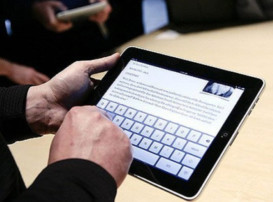Can you really ditch a standard computer and just use an iPad? This is now the #1 question I hear from my clients.
The question has become so prevalent, I recently gave a presentation on the subject at our local library in Altadena ... to a packed house. Later on in this column I'll provide you with a web link so you can download the free, comprehensive guide I created that will tell you what you need to know about learning and using the iPad, getting the most out of it, and using it like a computer. Speaking of which, let's cut to the chase and answer the burning question at hand.
A few years ago, when the iPad was introduced, the answer was a solid "NO." With the introduction of the iPad 2, the answer shifted to a "maybe." And now, with the iPad 3 and the soon-to-be released iPad 4 and iPad Mini -- and the advent of some specialized equipment and services -- the answer is a qualified "YES." Here's the short and sweet and why I used the word "qualified."
 If you use a laptop for what I call "the basics" -- surfing the web, sending and receiving email, and normal word processing or spreadsheet use -- you can now easily do all these things on an iPad, plus some things you can't do anywhere else. If, on the other hand, you use a computer for more complex tasks -- heavy video or audio editing on large files, specialty software such as music notation or statistics, complex spreadsheets with embedded macros, or 100 page-plus word processing documents -- you will be better served by a traditional computer with more horsepower and storage space.
If you use a laptop for what I call "the basics" -- surfing the web, sending and receiving email, and normal word processing or spreadsheet use -- you can now easily do all these things on an iPad, plus some things you can't do anywhere else. If, on the other hand, you use a computer for more complex tasks -- heavy video or audio editing on large files, specialty software such as music notation or statistics, complex spreadsheets with embedded macros, or 100 page-plus word processing documents -- you will be better served by a traditional computer with more horsepower and storage space.
And the issue of storage space is really what changed the iPad "no" to a "yes" this year. All computing devices have to store files you create with them somewhere; on a computer that would be the built-in hard drive, whether the traditional spinning disk type or the newer solid-state type. But iPads don't have a regular hard drive, nor can they accept an external storage drive: They are limited to the amount of internal memory they come with. Currently that's either 16GB, 32GB or at the most 64GB. If you're into storing a lot of videos, photos and music, that space can be eaten up quickly.
Thankfully the storage issue isn't a problem anymore with the advent of popular -- and often free -- cloud computing services. These services, such as Dropbox, Google Drive, Apple's iCloud and Microsoft's SkyDrive, allow you to save your files to the "cloud," not your device. Not only is this a boon for iPad users, it comes in handy because you can start a document on your computer, pick up where you left off on your iPad while out and about and continue working on it, then go home and finish the document back where you started it. Everything stays in sync, without you having to do anything at all. This "auto sync" model is popping up in more and more places, both on the web and inside apps on the iPad.
The other key factor in replacing a computer with an iPad is a useable keyboard. It's true that the iPad has an onscreen keyboard, and I've heard there are some people who are adept at using it to write email, send text messages and create word processing documents. I'm not one of them, and apparently I'm not alone in my sentiments. If you're going to try using an iPad instead of a computer, you need a real keyboard. There are now several BlueTooth-based keyboards to choose from, many of which come in an integrated case that also holds the iPad, turning it into a smaller, lighter version of a laptop.
I personally tested four such keyboards (you'll see them listed in my Resource Guide), and disliked all of them. Because the keyboard form factor has to match the size and shape of the iPad, the keys are smaller than normal. And many of the BlueTooth keyboards proved to be jerky and sluggish; in my testing, letters often became jumbled because the keyboard couldn't keep up with my typing speed... which wasn't as fast as I normally type! I don't know if this was a limitation of the keyboards' integration with BlueTooth or just a design flaw, but the overall experience was dismal.
Ultimately I settled on the reliable, well-built full-sized Apple Bluetooth Keyboard and an InCase Origami Workstation; the keyboard snaps into the Origami case which keeps it from moving, while the iPad sits at just the right angle for typing. The combination proved highly successful! My typing speed and accuracy returned, and the experience was virtually the same as using a regular desktop computer. Thanks to this keyboard and case combination, and the use of cloud computing services, I was happily working with the iPad as if it was a real computer.
The last piece of the puzzle is software that can let you do what you need to do, in a pleasing and efficient way, and that also facilitates getting actual work done. There isn't enough room in this column -- or even two or three -- to list all the software, services and accessories I found invaluable in my quest to use an iPad instead of a computer. So... I created the "iPad vs Computer Resource Guide
To get the guide, just click here, and the eight-page PDF I created will automatically download to your computer. The PDF also features built-in web links you can click on that will take to you all the products and services I describe. Enjoy!
Ken welcomes your questions and comments. Your question may also be featured in a future column! Ken can reached at ken@thetechdaddy.com.
